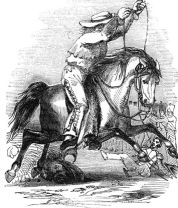 |
Mexican Land Grants |
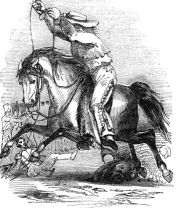 |
 |
Mexican Land Grants |
 |
| Links: SDHS: Joseph Snook | Rancho Bernardo History Center | |
The earliest inhabitants of the region now known as Rancho Bernardo, in San Diego county, were the Kumeyaay. A map made in 1800 identified the area as La Canada de San Bernardo and showed a native rancheria on the lands of the rancho, along the valley of the San Dieguito river. During mission days, 1769-1821, it was a cattle ranch under the control of mission San Diego de Alcala. In the 1820s a trail was established running from Old Town San Diego, through the San Dieguito valley, up the San Pasqual valley, on to Santa Ysabel, and into the desert. This would eventually become the stagecoach route to San Antonio, Texas. In 1837, during a period of native unrest, several men from the mission were killed at the rancho by the Kumeyaay.
On 16 February 1842 the governor of Alta California, Juan Bautista Alvarado, granted Jose Francisco Snook two leagues of land in the region. On 26 May 1845 Governor Pio Pico then granted Snook an additional two leagues, for a total of 17,763 acres. This became the Rancho La Canada de San Bernardo (Ranch of the Valley of the San Bernardo river).
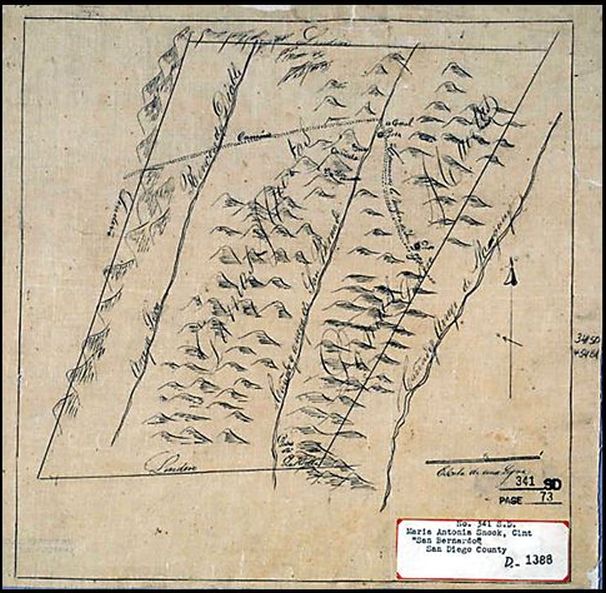
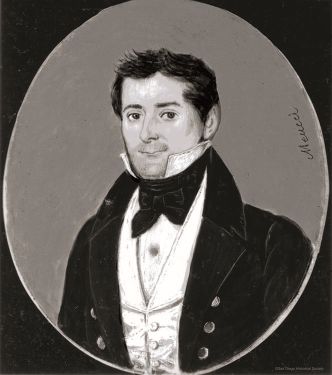
Snook was an Englishman, originally named Joseph; he changed his name on becoming a Mexican citizen and converting to Catholicism in 1833. He was a merchant ship captain who traded up and down the California coast and on into Mexico and Peru. In 1837 he married Maria Antonia Alvarado, the niece of Juan Bautista Alvarado, the governor of Alta California. Strangely, Antonia's father had the same name, Juan Bautista Alvarado. The latter was the grantee of Rancho El Rincon del Diablo, now Escondido, while his son, Jose, was the grantee of Rancho Vallecitos de San Marcos. Rancho Guejito y Canada de Palomia was owned by Jose María Orosco, María Snook’s brother-in-law. Another grant to the south of San Bernardo, Rancho Santa Maria de Los Penasquitos, was at this time owned by Francisco Maria Alvarado, a cousin perhaps of Snook's wife. The granting of land seems to have been highly incestuous.
San Bernardo was a classic ranch, running cattle, sheep, horses, mules and oxen. A visitor to the ranch said, in 1852, that the San Bernardo became "one of the largest stock-raising establishments in the country." The stock bore the Snook J-S brand. His hacienda was located at the northern end of today's Kit Carson creek, near an artesian spring that still flows today. The house was also located near the road from San Diego. The map below was drawn by an Army cartographer in the aftermath of the Battle of San Pasqual. The creek leading past "Snook's Rancho" is Kit Carson creek and continues down to the Rio San Bernardo, known today as the San Dieguito river. The Snooks also had a house in Old Town, on Fitch street.
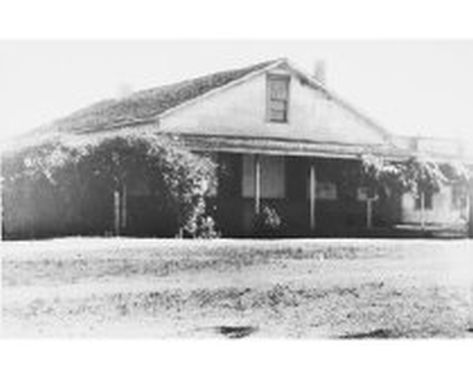
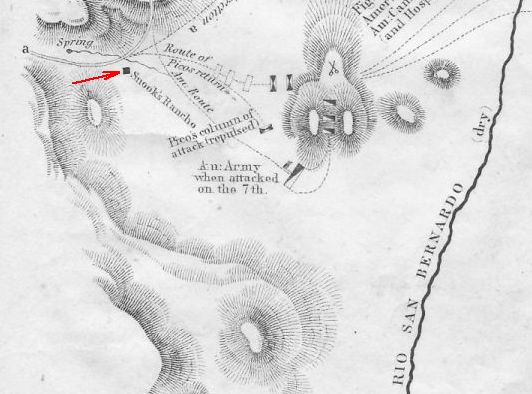
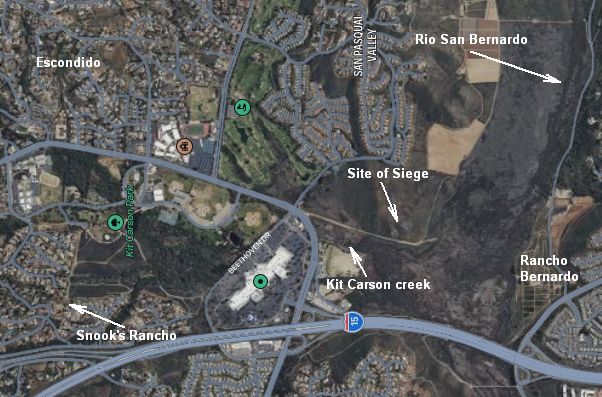
| Mexican Governors of Alta California
Luis Antonio Arguello 1822-1825 Jose Maria de Echeandia 1825-1831 Manuel Victoria 1831-1832 * Victoria's tenure as governor was unpopular and short-lived, owing to his anti-democratic reforms. His governorship ended following his defeat at the Battle of Cahuenga Pass in 1831, when Californios overthrew him. Pío Pico and Jose Maria de Echeandia (in the south), Agustin Vicente Zamorano (in the north) 1832-1833Rule was split following Victoria's defeat at the Battle of Cahuenga Pass, prior to the appointment of Figueroa in 1833. Jose Figueroa 1833-1835Jose Castro (acting) 1835-1836 Nicholas Gutierrez (acting) January-May 1836 Mariano Chico May-July 1836 * Chico was exiled after a popular uprising of Californios against his rule. Nicolas Gutierrez (acting) August-November 1836Following the appointments of unpopular governors Gutierrez and Chico, Juan Bautista Alvarado successfully led a popular uprising of Californios in 1836 which deposed Gutiérrez, proclaimed the independence of Alta California from Mexico, and named Alvarado as its president. Alvarado maintained effective control over California until he entered into negotiations with the Mexican central government in 1837, which resulted in the disbandment of Alta Californian independence in favor of greater autonomy from the Mexican government and recognition of Alvarado as Governor of Alta California. Juan Bautista Alvarado 1836-1842Manuel Micheltorena 1842-1845 * Micheltorena was deposed as governor after his defeat at the Battle of Providencia Pio Pico (in the south), Jose Castro (in the north) 1845-1846Following the American Conquest of California, the administration of Alta California came under control of the U.S. Military Governor of California. * Deposed by popular revolution |
In 1846, during the Mexican-American War, the American Army of the West, commanded by General Stephen Kearny, stopped at the Snook's hacienda to obtain water and seize supplies. See The Battle of San Pasqual for more about the battle. See Snook Adobe Site for more about the location of the Snook home. Both Joseph and Maria were absent from San Bernardo at the time, though two of Maria's brothers, Juan and Jose, were at the battle, fighting for the Mexicans. Juan had been injured in that battle and Jose was later killed during the 'Pauma Massacre.' Just about this time Snook had arrived in San Diego bay in his ship 'JUANITA,' where it was promptly seized by the U.S. Navy sloop-of-war 'CYANE.' Aboard were thousands of percussion caps, presumably to arm the Californios. Snook had previously shown his allegiance to the Mexican cause, alerting the Californios when American troops left Old Town to forage for cattle.
Snook died suddenly on 23 February 1848 and was buried in the old presidio chapel in San Diego. His will,
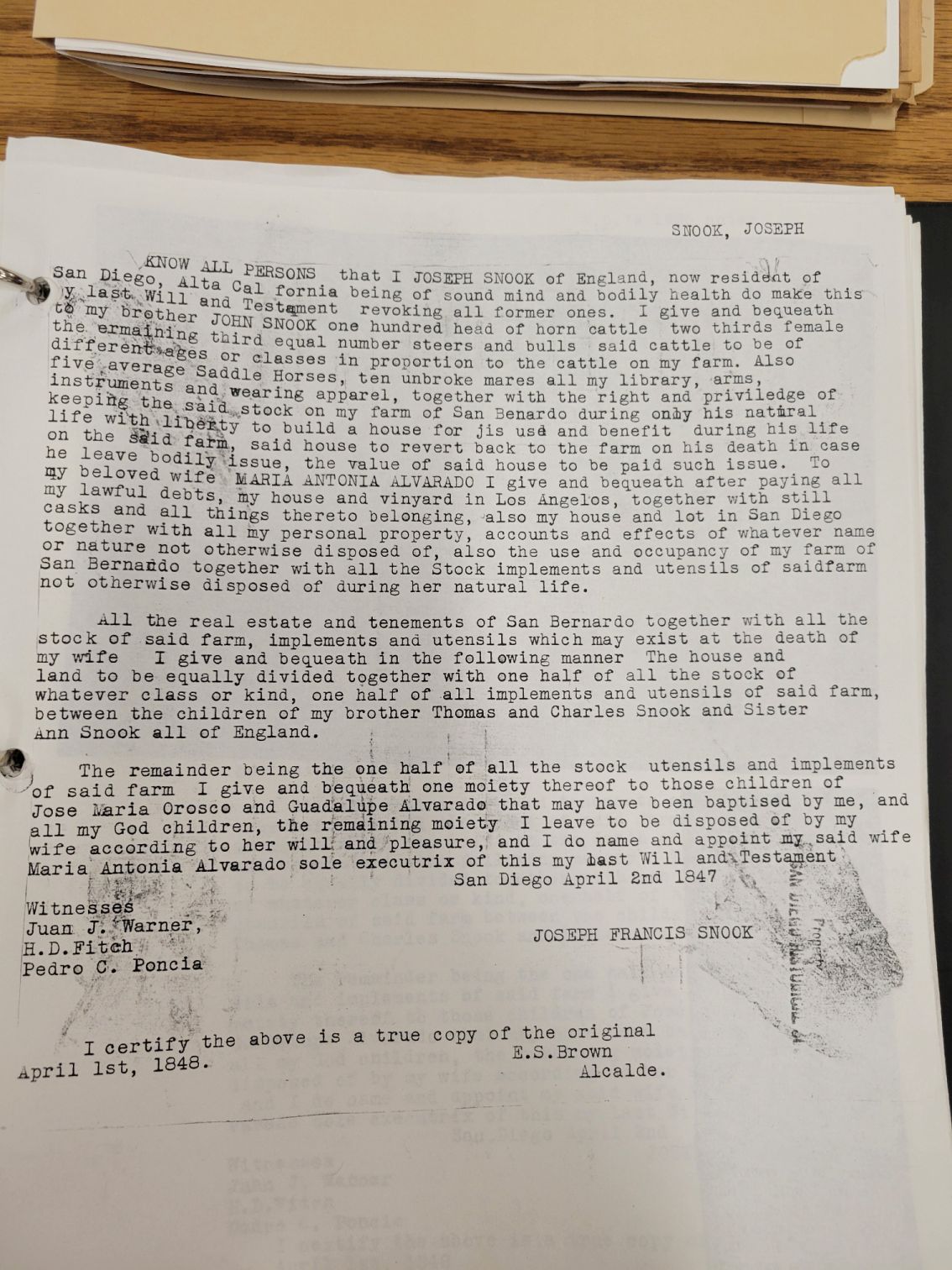
Note in Joseph's bequest to his brother, John, the phrase "with liberty to build a house for his use and benefit during his life on the said farm." It has been conjectured that this house was built and that it is the adobe core of the Zenas Sikes farmhouse on the lower reaches of Kit Carson creek. The older Joseph Snook adobe was at that creek's origins. According to the San Diego History Center, see link above, "by 1850 [John Snook] had built a house and corral worth $500."
Alexa Clausen, a local researcher, wrote,
"In looking through material relative to Rancho San Bernardo, J.F. Snook wrote his Will in 1847 and gifted to his brother, John a portion of Rcho Sn Bernardo to include livestock, etc. with rights to build a house. The site of the rancho house of Jos. and Maria Snook, then Clayton, has been located on a hill off El Ku on Sierra Street; and of course, not the Sikes adobe. J.S. passed in 1848.
John did come to California and lived on the Rancho. Could the portion of the rancho Jos. granted to John to build a house and live on became part of what Zenas purchased? It could explain the poor adobe wall construction, etc. [of the Sikes adobe]. John died in January 1852, not probated. The Snook family in England tried to get some inheritance but lost their case. Henry Clayton wrote them a "heck no" letter in August 1852. Years later, the nephew of Jos and John tried to get some land, however they too lost in court."
Joseph's brother, John Snook, had come out to San Diego by 1847, but he too died, in 1852.
"In his will Joseph left his library, arms, instruments and wearing apparel to his brother. John also received 100 head of cattle and other stock with the privilege of keeping them on the San Bernardo. In 1848 John registered his C-S brand and by 1850 had built a house and corral worth $500. In addition to ranching, John was active in San Diego politics; in the election of 1849, he ran for the office of prefect but lost to Santiago Arguello by a large margin.44 He failed to prosper, however, and when he died in 1852, “he died very poor and what property he had was not near sufficient to satisfy his creditors." - from San Diego Historical Center (link above)In 1853 Maria Antonia married Henry Clayton, an American surveryor with the Mexican boundary survey.
In the peace treaty that ended the Mexican-American War the US Government promised to respect the property rights of the Californio grantees. However, since few of the latter could show an adequate survey they were subjected to long, expensive legal battles to prove their claims. A decline in cattle prices and droughts in the early 1860's further squeezed the grantees resulting in many of the ranchos being sold off and subdivided.
Antonia Snook died from smallpox in 1862, terminating her life interest in the rancho. The Snooks had no children of their own so Joseph's brothers and sisters in England were the next heirs.
In 1867 Snook's siblings sold the rancho to Thomas Fox, who was acting for James McCoy, a sheriff and state senator from San Diego. The price paid was $4,020 - from the San Diego Historical Center [or $36,000 per another source, or about $2 and acre]. On 5 December 1868 McCoy sold a quarter share of the property to Charles Wetmore, a half share to Sylvester Lyman, and a quarter share to Omar Oaks. Lyman and Wetmore, in turn, subdivided their property into smaller ranches. On 8 December Zenas Sikes bought 1/2 of Wetmore's interest, that is, an eighth share, or 2,400 acres, for $2,500. See "The History of the Zenas Sikes Family," below.
For the next century, Rancho Bernardo was a stopping-off point for travelers heading between the north and San Diego. It was made up of a collection of private ranches, treeless grazing land, and small farms.